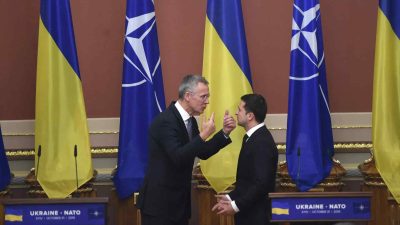Ukraine War: Not About NATO…Until Now?

All Global Research articles can be read in 51 languages by activating the Translate Website button below the author’s name.
To receive Global Research’s Daily Newsletter (selected articles), click here.
Click the share button above to email/forward this article to your friends and colleagues. Follow us on Instagram and Twitter and subscribe to our Telegram Channel. Feel free to repost and share widely Global Research articles.
***
As Matt Taibbi writes,
None of this justifies Russia’s invasion. It is however crucial to understand, as Stoltenberg just confirmed, that war in Ukraine is taking place on a long historical continuum of controversy over NATO expansion and that the relentless messaging to the contrary in the US is just the latest coordinated deception campaign Americans have had to swallow.
After over a year of the media repeating that the Ukraine War is “not about NATO,” just last month, the head of NATO himself, Secretary General Jens Stoltenberg, came out to say Putin’s invasion was about NATO: “He went to war to prevent NATO, more NATO, across his borders.”
The background was that President Putin declared in the autumn of 2021, and actually sent a draft treaty that they wanted NATO to sign, to promise no more NATO enlargement… a pre-condition [to] not invade Ukraine. Of course we didn’t sign that.
The opposite happened. He wanted us to sign that promise, never to enlarge NATO. He wanted us to remove our military infrastructure in all Allies that have joined NATO since 1997, meaning half of NATO, all the Central and Eastern Europe, we should remove NATO from that part of our Alliance, introducing some kind of B, or second class membership. We rejected that. So he went to war to prevent NATO, more NATO, across his borders.
So why has the official narrative suddenly changed from “Not About NATO” to the head of NATO himself saying otherwise? Well, in order to point out that Russia’s goal of preventing more NATO expansion has failed (with NATO expanding to Finland and Sweden), amusingly, the West has to acknowledge that it was, in fact, Russia’s goal to prevent more NATO expansion in the first place.
So he went to war to prevent NATO, more NATO, acress his borders. He has got the exact opposite. He has got more NATO presence in eastern part of the Alliance and he has also seen that Finland has already joined the Alliance and Sweden will soon be a full member.
In a 2017 interview with Oliver Stone, Putin explained why he considered NATO expansion into Ukraine as a “threat”.
STONE: Even if NATO made an agreement with Ukraine, I still don’t see a threat to Russia.
PUTIN: I see a threat. The threat consists in fact that once NATO comes to this or that country, the political leadership of that country as a whole, along with its population, cannot influence the decisions NATO takes, including the decisions related to stationing the military infrastructure. Even very sensitive weapon systems can be deployed. I’m talking about anti-ballistic military systems.
Regardless of how unjustified the invasion was, that’s at least part of the rationale. Consider how the United States would react if Russia were to place missile systems in Mexico pointing towards the United States. Likewise, NATO itself has been put on edge after Russia’s expansion into Ukraine. The only way to de-escalate to a peace agreement is to first acknowledge these valid concerns. Unfortunately, instead of explaining that, media on both sides continue to escalate the tension by ignoring nuance in order to paint the other party as simply “evil”.
*
Note to readers: Please click the share button above. Follow us on Instagram and Twitter and subscribe to our Telegram Channel. Feel free to repost and share widely Global Research articles.
Featured image is from InfoBrics

